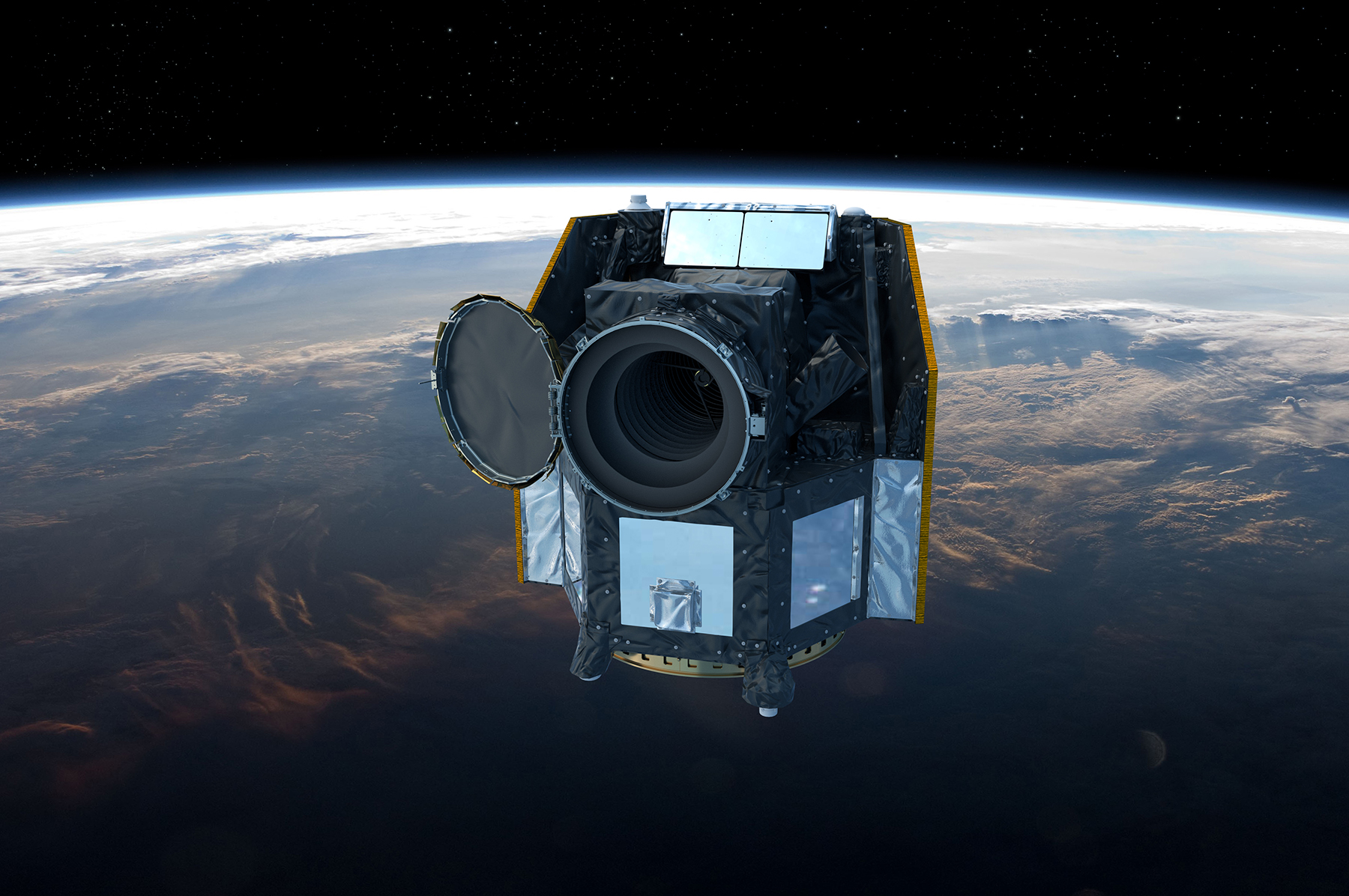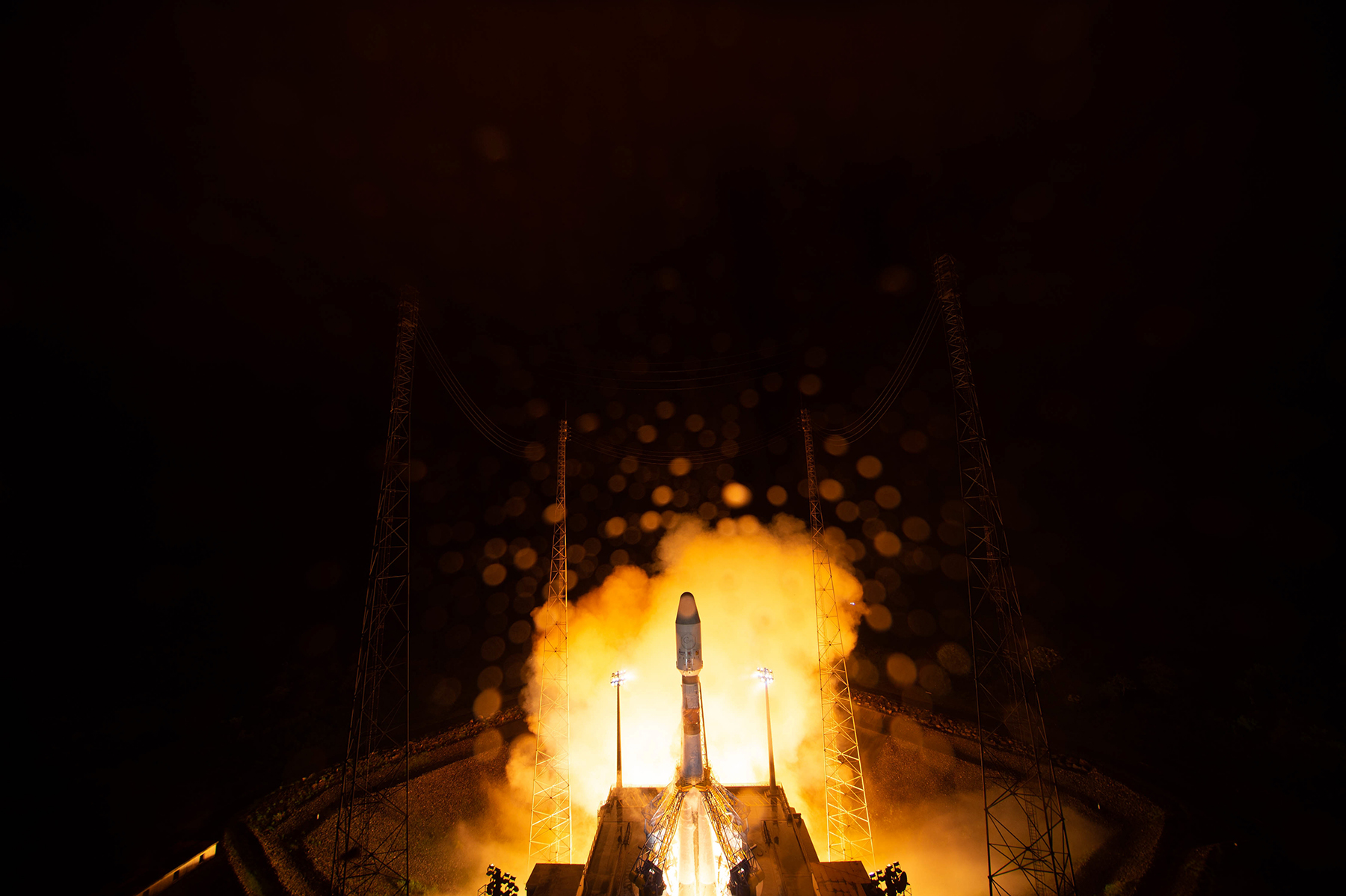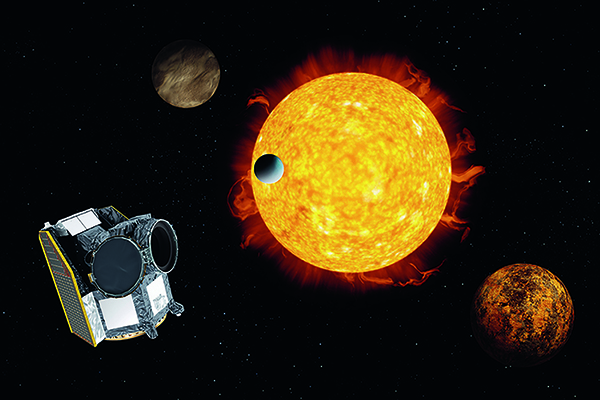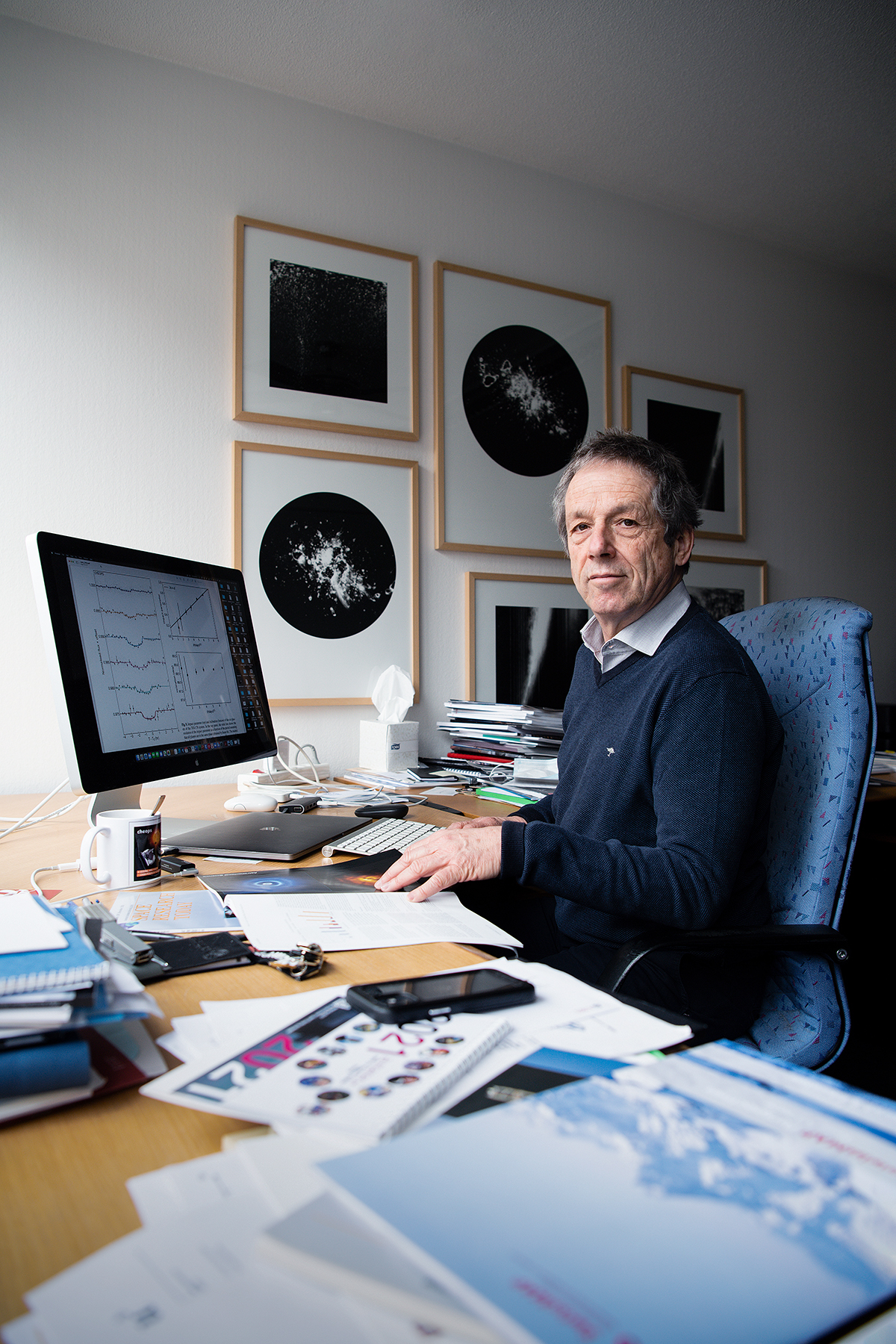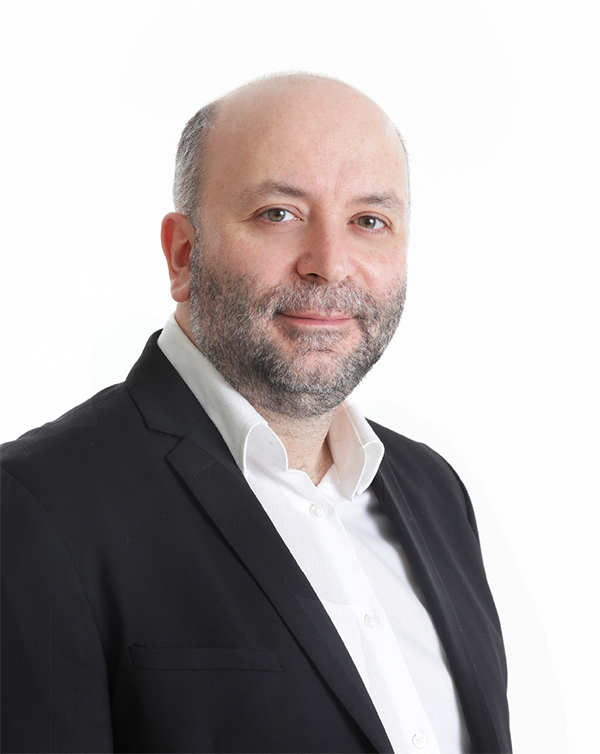CHEOPS mission extended
After more than three years in orbit, the mission of the CHEOPS space telescope has just been extended. Led by the University of Bern in collaboration with the University of Geneva, CHEOPS is a joint mission of the European Space Agency (ESA) and Switzerland. On March 7th, ESA’s Science Programme Committee has confirmed its continued operations to 2026 and an indicative extension to 2029, contingent upon ongoing commitments from national contributors and partners. Since its launch in December 2019, the satellite’s extremely precise measurements have contributed to several key discoveries in the field of exoplanets. The extension will make it possible to study these fascinating worlds around other stars in even more detail.
Unlike previous satellites designed to find new exoplanets – planets orbiting stars other than our Sun – by observing tens of thousands of stars simultaneously, CHEOPS has been optimized to observe a single star at a time and it targets stars already known to host exoplanets. The aim of CHEOPS is therefore to go beyond a mere census of exoplanets, and measure some of their key characteristics, in particular their size, with an exquisite precision. This precision is what allows astronomer to infer what these planets are made of: combining the CHEOPS size measurement with the previously known planet mass yields the density: dense planets like the Earth are mainly composed of rocks and metals, while planets with low densities like Jupiter are mostly made out of gas. Since these compositions are the result of the planet formation process, getting to know them opens a window to the past history of planetary systems, putting our own Solar System in context.
Observation of exoplanet properties
“In this respect, the mission has been extremely successful,” highlights Willy Benz, Professor emeritus of astrophysics at the University of Bern and head of the CHEOPS consortium, “the precision of CHEOPS has exceeded all expectations and has allowed us to determine properties of several of the most interesting exoplanets.”
For example, by closely observing how the luminosity changes as the planet WASP-103b passes in front of its star, scientists from the CHEOPS team have observed that the planet is deformed into the shape of a rugby ball due to the intense gravity of the nearby star. Such planets are so hot that CHEOPS has also been able to detect them glowing along their orbit around their stars. “The glow detected with CHEOPS for the planet WASP-189b is only a few millionth of the light emitted by the star, and is related to the temperature of the planet atmosphere and its cloud coverage. So it is clear that CHEOPS can do much more than ‘simply’ measuring planet sizes,” explains Prof. David Ehrenreich of the University of Geneva, who is co-chairing the international team of over a hundred of scientists involved in the exploitation of the mission.
More exciting discoveries with the extended mission
The primary mission of CHEOPS was planned to last for three and a half years, that is until September 2023. The outstanding quality of the science produced by the mission is attested by the publication of over fifty scientific articles based on CHEOPS data in international journals. The satellite was successfully operated amidst a global pandemic, and its health is excellent with respect to the harsh conditions of space, where it is constantly bombarded by cosmic rays and high-energy radiation. All these elements have pushed the CHEOPS team to propose extending the mission beyond 2023.
The extension of CHEOPS operations has now been confirmed by the ESA Science Programme Committee until at least 2026, provided ongoing support from national contributors and partners. The CHEOPS team members are originating from 40 institutions across Europe: in addition to ESA, 11 countries, including Switzerland in a leading role, have come together to fund and build the telescope between 2012 and 2019. “CHEOPS can continue to count on the strong support of the participating Funding Agencies, including Switzerland, for the extension of the mission, and that the Swiss lead in the CHEOPS mission (including its extended operations) is possible due to the membership of Switzerland in ESA and through its participation in the PRODEX program,” says Oliver Botta, chair of the CHEOPS Steering Committee.
With the newly approved mission extension, the CHEOPS team plans to continue using CHEOPS for what it does best while at the same time trying out new observations. “We have only scratched the surface of the capabilities of CHEOPS, there is much more science that can be done with the satellite and we look forward to exploring it during the extension,” declares Benz. “A very exciting result would be the discovery of the first exomoon,” reveals Ehrenreich. “Many planets in our Solar System have moons, so we expect to find some around exoplanets, and we are currently observing some candidates. It is challenging to detect exomoons though, because they are small, hence their signatures are faint. However, CHEOPS is precise enough to find exomoons as small as the planet Mars, which is twice the size of our Moon. If such moons exist in the systems we observe, we could find them during the extended mission.”
A unique role in the landscape of space missions
Another unique characteristic of CHEOPS is its ability to combine forces with other space missions such as the James Webb Space Telescope (JWST), which is a joint mission of NASA and ESA. CHEOPS can refine our knowledge of already known exoplanets to select the best candidates to be observed with JWST to probe the atmospheres of these planets. “Thanks to CHEOPS observations, we have been granted valuable JWST time to observe the planets in the TOI-178 system to determine their atmospheric composition, which will help to understand the dynamical history of the system,” specifies Prof. Yann Alibert of the University of Bern. Alibert is coordinating the CHEOPS program dedicated to the follow-up of multiplanetary systems discovered by NASA’s satellite TESS. “This is an example of a great synergy between CHEOPS and other missions: TESS originally found 3 planets orbiting the star TOI-178. When CHEOPS looked at this system, it discovered three more planets and revealed an outstanding and fragile orbital harmony, leading us to hypothesize that it has been unperturbed for billions of years,” explains Alibert.
“Scientists are eager to find out what surprising results CHEOPS will bring next; what is sure now is that CHEOPS will continue to make new discoveries for years to come,” concludes Benz.
CHEOPS – in search of potential habitable planetsThe CHEOPS mission (CHaracterising ExOPlanets Satellite) is the first of ESA’s “S-class missions” – small-class missions with an ESA budget much smaller than that of large- and medium-size missions, and a shorter timespan from project inception to launch. CHEOPS is dedicated to characterizing the transits of exoplanets. It measures the changes in the brightness of a star when a planet passes in front of that star. This measured value allows the size of the planet to be derived, and for its density to be determined on the basis of existing data. This provides important information on these planets – for example, whether they are predominantly rocky, are composed of gases, or if they have deep oceans. This, in turn, is an important step in determining whether a planet has conditions that are hospitable to life. CHEOPS was developed as part of a partnership between the European Space Agency (ESA) and Switzerland. Under the leadership of the University of Bern and ESA, a consortium of more than a hundred scientists and engineers from eleven European states was involved in constructing the satellite over five years. CHEOPS began its journey into space on Wednesday, December 18, 2019 on board a Soyuz Fregat rocket from the European spaceport in Kourou, French Guiana. Since then, it has been orbiting the Earth on a polar orbit in roughly an hour and a half at an altitude of 700 kilometers following the terminator. The Swiss Confederation participates in the CHEOPS telescope within the PRODEX program (PROgramme de Développement d'EXpériences scientifiques) of the European Space Agency ESA. Through this program, national contributions for science missions can be developed and built by project teams from research and industry. This transfer of knowledge and technology between science and industry ultimately also gives Switzerland a structural competitive advantage as a business location – and enables technologies, processes and products to flow into other markets and thus generate added value for our economy. More information: https://cheops.unibe.ch |
Bernese space exploration: With the world’s elite since the first moon landingWhen the second man, "Buzz" Aldrin, stepped out of the lunar module on July 21, 1969, the first task he did was to set up the Bernese Solar Wind Composition experiment (SWC) also known as the “solar wind sail” by planting it in the ground of the moon, even before the American flag. This experiment, which was planned, built and the results analyzed by Prof. Dr. Johannes Geiss and his team from the Physics Institute of the University of Bern, was the first great highlight in the history of Bernese space exploration. Ever since Bernese space exploration has been among the world’s elite, and the University of Bern has been participating in space missions of the major space organizations, such as ESA, NASA, and JAXA. With CHEOPS the University of Bern shares responsibility with ESA for a whole mission. In addition, Bernese researchers are among the world leaders when it comes to models and simulations of the formation and development of planets. The successful work of the Department of Space Research and Planetary Sciences (WP) from the Physics Institute of the University of Bern was consolidated by the foundation of a university competence center, the Center for Space and Habitability (CSH). The Swiss National Fund also awarded the University of Bern the National Center of Competence in Research (NCCR) PlanetS, which it manages together with the University of Geneva. |
Exoplanet research in Geneva: 25 years of expertise awarded a Nobel PrizeCHEOPS provides crucial information on the size, shape, formation and evolution of known exoplanets. The installation of the "Science Operation Center" of the CHEOPS mission in Geneva, under the supervision of two professors from the UNIGE Astronomy Department, is a logical continuation of the history of research in the field of exoplanets, since it is here that the first was discovered in 1995 by Michel Mayor and Didier Queloz, winners of the 2019 Nobel Prize in Physics. This discovery has enabled the Astronomy Department of the University of Geneva to be at the forefront of research in the field, with the construction and installation of HARPS on the ESO's 3.6m telescope at La Silla in 2003, a spectrograph that remained the most efficient in the world for two decades to determine the mass of exoplanets. However, this year HARPS was surpassed by ESPRESSO, another spectrograph built in Geneva and installed on the VLT in Paranal. CHEOPS is therefore the result of two national expertises, on the one hand the space know-how of the University of Bern with the collaboration of its Geneva counterpart and on the other hand the ground experience of the University of Geneva supported by its colleague in the Swiss capital. Two scientific and technical competences that have also made it possible to create the National Center of Competence in Research (NCCR) PlanetS. |
2023/03/09

